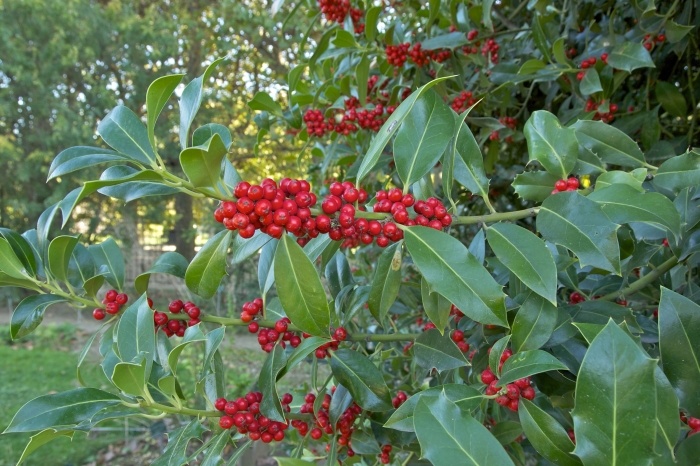English Holly
(Ilex aquifolium)
English Holly (Ilex aquifolium)
/
/

Jebulon
CC0
Image By:
Jebulon
Recorded By:
Copyright:
CC0
Copyright Notice:
Photo by: Jebulon | License Type: CC0 | License URL: http://creativecommons.org/publicdomain/zero/1.0/deed.en | Uploader: Jebulon | Publisher: Wikimedia Commons | Title: Ilex_aquifolium_L._JdP.jpg |

























Estimated Native Range
Summary
Ilex aquifolium, commonly known as English Holly, is an evergreen tree or shrub native to western and southern Europe and northwest Africa. It thrives in a variety of habitats, including deciduous woodlands, forest margins, and heathlands, often on moist, well-drained soils. English Holly typically reaches 2–3 m (6.6–9.8 ft) in cultivation but can grow up to 10–25 m (33–82 ft) tall in ideal conditions. It has a straight trunk, a pyramidal crown, and is notable for its glossy, dark green, spiny leaves and bright red berries on female plants, which require male plants for pollination. The berries mature in late autumn and are a food source for birds and other wildlife after frost has made them palatable.
English Holly is valued for its ornamental qualities, including its striking evergreen foliage and vibrant berries, which contribute to its use in Christmas decorations. It is a versatile plant used for hedges, due to its dense growth and spiny leaves, and for topiary, as it responds well to pruning. In cultivation, it prefers partial shade to full sun, moist but well-drained soil, and can tolerate a range of conditions, including frost and summer drought. However, it can be susceptible to holly leaf miner, scale insects, and holly leaf blight. Gardeners should be aware of its potential invasiveness in non-native areas, such as the west coast of North America, where it can outcompete local flora.CC BY-SA 4.0
English Holly is valued for its ornamental qualities, including its striking evergreen foliage and vibrant berries, which contribute to its use in Christmas decorations. It is a versatile plant used for hedges, due to its dense growth and spiny leaves, and for topiary, as it responds well to pruning. In cultivation, it prefers partial shade to full sun, moist but well-drained soil, and can tolerate a range of conditions, including frost and summer drought. However, it can be susceptible to holly leaf miner, scale insects, and holly leaf blight. Gardeners should be aware of its potential invasiveness in non-native areas, such as the west coast of North America, where it can outcompete local flora.CC BY-SA 4.0
Plant Description
- Plant Type: Shrub, Tree
- Height: 15-40 feet
- Width: 10-15 feet
- Growth Rate: Slow
- Flower Color: N/A
- Flowering Season: Spring
- Leaf Retention: Evergreen
Growth Requirements
- Sun: Full Sun, Part Shade
- Water: Medium
- Drainage: Fast, Medium, Slow
Common Uses
Bank Stabilization, Bee Garden, Bird Garden, Border Plant, Butterfly Garden, Deer Resistant, Drought Tolerant, Fragrant, Hedges, Rabbit Resistant, Salt Tolerant, Street Planting
Natural Habitat
native to western and southern Europe and northwest Africa
Other Names
Common Names:
Scientific Names: Ilex aquifolium , Ilex balearica , Ilex vulgaris , Ilex aquifolium var. heterophylla , Aquifolium ilex , Ilex spinigera , Ilex aquifolium f. aureomarginata , Ilex aquifolium var. balearica , Ilex ferox , Ilex aquifolium f. arbutifolia
GBIF Accepted Name: Ilex aquifolium L.